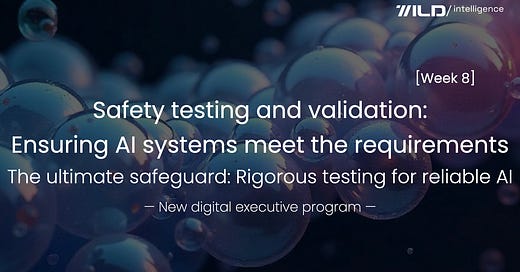🚀 Safety testing and validation: Ensuring AI systems meet the requirements [Week 8]
The ultimate safeguard: Rigorous testing for reliable AI | A 12-week executive master program for busy leaders
![🚀 Safety testing and validation: Ensuring AI systems meet the requirements [Week 8] | The power of partnership: Combining human intelligence and AI | A 12-week executive master program for busy leaders 🚀 Safety testing and validation: Ensuring AI systems meet the requirements [Week 8] | The power of partnership: Combining human intelligence and AI | A 12-week executive master program for busy leaders](https://substackcdn.com/image/fetch/$s_!U1ej!,w_1456,c_limit,f_auto,q_auto:good,fl_progressive:steep/https%3A%2F%2Fsubstack-post-media.s3.amazonaws.com%2Fpublic%2Fimages%2F1c0285e9-4697-4fa8-b395-407d623453f1_1920x1080.png)
The AI safety landscape
The transformative power of AI is undeniable.
It's reshaping industries, accelerating scientific discovery, and promising solutions to humanity's most pressing challenges.
Yet, this remarkable potential is intertwined with significant threats.
As AI systems become more complex and integrated into critical aspects of our lives, ensuring their safety and reliability is paramount.
We cannot afford to observe AI's evolution passively; we must actively shape its trajectory, guiding it toward a future where its benefits are maximized, and its risks are minimized.
🚀 Safety testing and validation: Ensuring AI systems meet the requirements
Before AI systems are deployed into the real world, especially in safety-critical applications, they must undergo rigorous testing and validation.
This process ensures that AI systems meet predefined safety requirements, function as intended, and do not pose unacceptable risks. Safety testing and validation are not simply a final check; they are an integral part of the AI development lifecycle, ensuring safety is built into the system from the ground up.
This week, we delve into the critical role of safety testing and validation in AI development. We explore different testing methodologies, discuss the importance of defining clear and precise safety requirements, and provide strategic guidance for implementing comprehensive testing and validation procedures.
By prioritizing rigorous testing, we can identify and address potential safety issues before they lead to harmful consequences, ensuring the reliability and trustworthiness of AI systems.
How can organizations effectively balance the need for comprehensive and rigorous safety testing with AI development's time and resource constraints, ensuring that safety is prioritized without hindering innovation and deployment?


